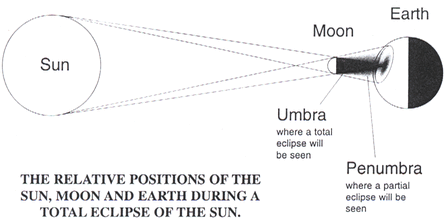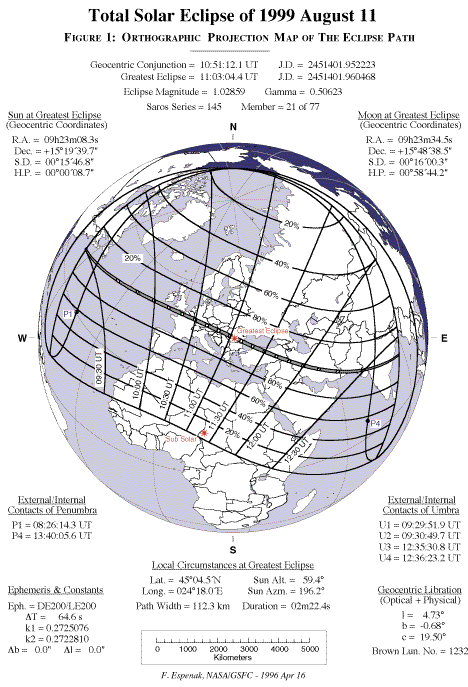Skip over navigation
Article by NRICH team
Eclipses are as old as the Earth. Ancient peoples saw the sun as the source of all warmth, light and life, and so were very upset when the sun disappeared. There are many old stories that recognise that it is the moon covering the sun, but try to explain what happens by saying the moon is arguing with the sun, or that they left the sky to check on things down on Earth. Some cultures thought the sun was being eaten by a dragon or some other monster, and made lots of noise to frighten it away. (It always worked, didn't it?!)

An eclipse occurs when the moon passes in front of the sun and can be seen from somewhere on Earth. If the moon is quite lined up across the middle of the sun, it is a Partial Eclipse. Depending on were the moon and Earth are in their obits (remember they travel an ellipse not a circle), sometimes the moon looks smaller than the sun, sometimes bigger. If the moon looks smaller it won't completely cover the sun even when it crosses the middle. This is called an Annular Eclipse. When the moon looks bigger, it can completely cover the sun, causing a Total Eclipse. The moon casts a shadow, called the Umbra, down on the Earth, and you must be under this shadow to actually see the Total Eclipse. The path this shadow traces as the earth turns is called the Path of Totality. Outside this shadow path, the eclipse will look like a Partial Eclipse.
Mathematics has allowed us now to measure lots of things about eclipses and so calculate exactly when they will happen, where they can be seen from, and what they will look like.

The total eclipse of the sun that took place on August 11th 1999 could be seen from parts of Europe, the Middle East and South Asia. It was the 21st eclipse in a series of eclipses that was reported by van den Berg in 1955. This series is called Saros 145, and its first eclipse (just a short partial eclipse) took place in the year 1639. The series will last for a total of 1370.3 years, ending in the year 3009 after 77 eclipses. The series began high up in the Northern Hemisphere and is gradually moving southward. The next one in this series will happen in 2017 over the USA. The time that the sun is covered is increasing, until in 2522 it will be dark for 7 minutes. Then the eclipses will gradually become shorter again.



Or search by topic
Number and algebra
Geometry and measure
Probability and statistics
Working mathematically
Advanced mathematics
For younger learners
Age 7 to 14
Published 2011
Eclipses of the Sun
Eclipses are as old as the Earth. Ancient peoples saw the sun as the source of all warmth, light and life, and so were very upset when the sun disappeared. There are many old stories that recognise that it is the moon covering the sun, but try to explain what happens by saying the moon is arguing with the sun, or that they left the sky to check on things down on Earth. Some cultures thought the sun was being eaten by a dragon or some other monster, and made lots of noise to frighten it away. (It always worked, didn't it?!)

An eclipse occurs when the moon passes in front of the sun and can be seen from somewhere on Earth. If the moon is quite lined up across the middle of the sun, it is a Partial Eclipse. Depending on were the moon and Earth are in their obits (remember they travel an ellipse not a circle), sometimes the moon looks smaller than the sun, sometimes bigger. If the moon looks smaller it won't completely cover the sun even when it crosses the middle. This is called an Annular Eclipse. When the moon looks bigger, it can completely cover the sun, causing a Total Eclipse. The moon casts a shadow, called the Umbra, down on the Earth, and you must be under this shadow to actually see the Total Eclipse. The path this shadow traces as the earth turns is called the Path of Totality. Outside this shadow path, the eclipse will look like a Partial Eclipse.
Mathematics has allowed us now to measure lots of things about eclipses and so calculate exactly when they will happen, where they can be seen from, and what they will look like.

The total eclipse of the sun that took place on August 11th 1999 could be seen from parts of Europe, the Middle East and South Asia. It was the 21st eclipse in a series of eclipses that was reported by van den Berg in 1955. This series is called Saros 145, and its first eclipse (just a short partial eclipse) took place in the year 1639. The series will last for a total of 1370.3 years, ending in the year 3009 after 77 eclipses. The series began high up in the Northern Hemisphere and is gradually moving southward. The next one in this series will happen in 2017 over the USA. The time that the sun is covered is increasing, until in 2522 it will be dark for 7 minutes. Then the eclipses will gradually become shorter again.
You may also like
The Moving Planets
Mathematics has always been a powerful tool for studying, measuring and calculating the movements of the planets, and this article gives several examples.
Shaping the Universe I - Planet Earth
This article explores ths history of theories about the shape of our planet. It is the first in a series of articles looking at the significance of geometric shapes in the history of astronomy.
Shaping the Universe II - the Solar System
The second in a series of articles on visualising and modelling shapes in the history of astronomy.

